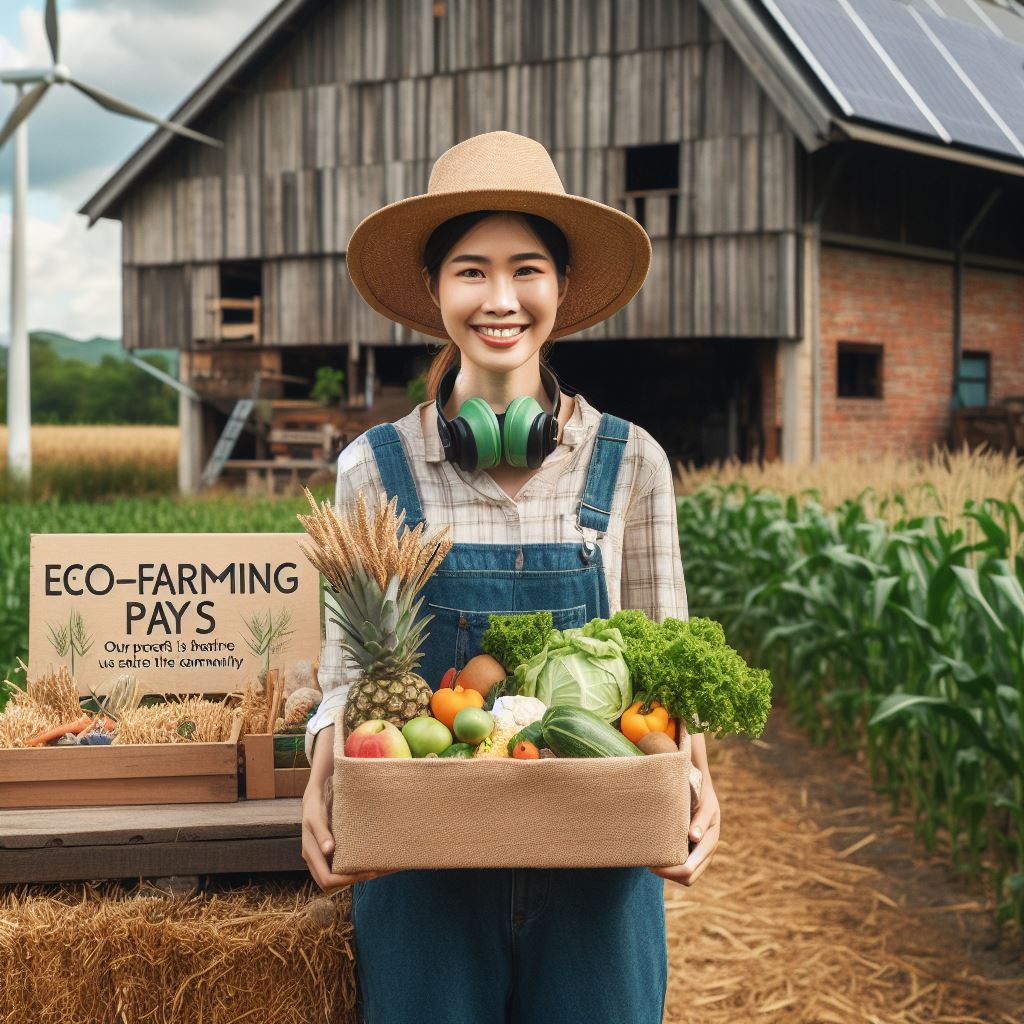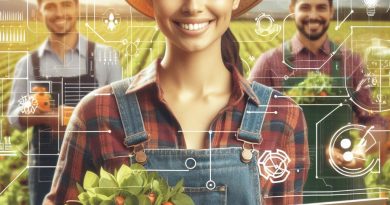Sustainable Agri: Cost vs. Benefit
Last Updated on March 2, 2024
Introduction
A. The concept of sustainable agriculture
Sustainable Agri Cost vs Benefit emphasizes farming techniques that prioritize the enduring well-being of the ecosystem.
It emphasizes soil health, water conservation, biodiversity, and reduced chemical usage.
By fostering resilience and minimizing environmental impact, sustainable agriculture ensures long-term food security and ecological balance.
B. The importance of considering cost versus benefit in sustainable agriculture practices
Evaluating the cost versus benefit is integral to sustainable agriculture, ensuring both economic viability and environmental preservation.
In sustainable agriculture, evaluating cost versus benefit is crucial for informed decision-making.
Balancing the economic aspects of implementing eco-friendly practices against the long-term benefits ensures viability.
While some practices may have initial costs, the overall gains in soil health, reduced environmental impact, and improved resilience often prove financially advantageous.
This consideration is key to achieving a sustainable equilibrium in agricultural systems.
Read: Green Agriculture: Brand Benefits
Benefits of Sustainable Agriculture
Sustainable agriculture offers numerous benefits to both the environment and society.
Let us explore these advantages in more detail.
A. Environmental benefits
One of the key benefits of sustainable agriculture is the conservation of natural resources.
By implementing practices such as crop rotation and cover cropping, farmers can reduce soil erosion and maintain soil fertility.
This conservation of resources ensures the long-term sustainability of agricultural lands.
Additionally, sustainable agriculture focuses on reducing chemical inputs.
Conventional farming practices often rely heavily on synthetic pesticides and fertilizers, which can contaminate water sources and harm ecosystems.
Sustainable agriculture promotes the use of organic and natural methods, minimizing the negative impacts on the environment.
Moreover, sustainable agriculture prioritizes improving soil health.
By adopting techniques like composting and conservation tillage, farmers can enhance soil structure, water-holding capacity, and nutrient cycling.
Healthy soils are vital for long-term agricultural productivity and contribute to a more resilient ecosystem.
B. Social benefits
Sustainable agriculture also brings several social benefits.
It contributes to enhanced food and water security by promoting diverse cropping systems and efficient water management practices.
Sustainable farms are better equipped to adapt to climatic changes and ensure a stable food supply for communities.
Furthermore, sustainable agriculture plays a crucial role in preserving biodiversity.
The use of agroforestry systems, natural habitats, and integrated pest management methods creates favorable conditions for diverse plant and animal species.
This biodiversity conservation is essential for maintaining ecological balance and supporting overall ecosystem health.
In addition, sustainable agriculture fosters healthier communities.
With reduced exposure to harmful chemicals and greater focus on organic farming, consumers have access to healthier food options.
Sustainable agriculture also promotes local food systems, allowing communities to create stronger connections with farmers and have a better understanding of where their food comes from.
C. Economic benefits
Sustainable agriculture offers significant economic advantages. While initial adoption costs may be higher, sustainable practices result in long-term cost savings.
By minimizing the use of chemical inputs and implementing efficient resource management, farmers can reduce production expenses and improve their overall profitability.
Furthermore, there is a growing market demand for sustainable products.
Consumers increasingly prioritize environmentally friendly and socially responsible choices.
This demand creates opportunities for farmers practicing sustainable agriculture to access premium markets and command higher prices for their products.
Lastly, sustainable agriculture contributes to job creation in the agricultural sector.
As farmers adopt sustainable practices, more labor is required to carry out tasks such as crop rotation, composting, and natural pest control.
This job creation stimulates local economies and provides employment opportunities within rural communities.
In general, sustainable agriculture presents a range of benefits that span environmental, social, and economic dimensions.
By implementing conservation practices, reducing chemical inputs, and prioritizing soil health, farmers can protect natural resources, preserve biodiversity, and create a healthier and more sustainable future for all.
Furthermore, the economic benefits of cost savings and market demand for sustainable products contribute to the overall viability and growth of the agricultural sector.
Read: Agri-Tech’s Role in Farm Diversification
Costs of Sustainable Agriculture
Sustainable agriculture is a noble pursuit, yet its path is not paved with gold.
The journey demands a careful weighing of costs and benefits.
A. Initial Investment
- Acquisition of Sustainable Farming Equipment: Sustainable practices require modern tools—a financial leap, but one towards eco-friendly efficiency.
- Adoption of New Practices and Techniques: Investing in knowledge pays dividends. The cost of learning sustainable techniques sets the foundation for a resilient future.
B. Learning Curve and Training
- Time and Effort Required to Transition: Transitioning to sustainable methods is no sprint. Patience is essential, as time and effort are expended on this transformative journey.
- Need for Training Programs and Education: Education is the cornerstone of sustainability. Training programs become vital, ensuring farmers possess the skills to thrive in this evolving landscape.
C. Potential Decrease in Short-term Productivity or Profit
- Initial Adjustments and Reduced Yields: Change is met with challenges. Initial adjustments may lead to reduced yields, a temporary setback on the road to sustainability.
- Economic Impact During the Transition Phase: As the pendulum swings towards sustainability, there might be a dip in profits. This economic shift is the cost of a brighter, greener future.
In the realm of sustainable agriculture, every investment is a seed sown for a harvest that transcends profit—a legacy of environmental stewardship.
While costs may ripple through the balance sheet, the benefits extend far beyond, creating a sustainable equilibrium for generations to come.
Read: Vertical Farming: Future of Agribusiness?

Gain More Insights: Farm Export: Legal Essentials
Evaluating the Cost-Benefit Ratio
Sustainable agriculture requires an evaluation of the cost-benefit ratio to determine its overall viability.
By assessing both the long-term benefits and the overall costs, stakeholders can make informed decisions.
A. Assessing the long-term benefits
To truly understand the value of sustainable agriculture, it is crucial to analyze its impact on the environment.
By adopting sustainable farming practices, such as organic farming and crop rotation, the detrimental effects of conventional agriculture can be minimized or even reversed.
Furthermore, sustainable agriculture offers various social advantages.
It promotes community development by preserving rural areas and ensuring the availability of fresh and healthy food for everyone.
Additionally, sustainable farming practices can enhance biodiversity and protect natural resources, contributing to a better quality of life for future generations.
From an economic perspective, sustainable agriculture can lead to significant gains.
By investing in sustainable practices, farmers often benefit from increased productivity and reduced input costs over time.
Moreover, the growing demand for sustainably produced goods presents opportunities for market differentiation and higher prices.
B. Estimating the overall costs
While the benefits of sustainable agriculture are compelling, it is essential to consider the associated costs.
Calculating the initial investment required to implement sustainable practices, such as purchasing organic-certified seeds or upgrading equipment, is crucial.
Additionally, ongoing expenses, such as higher labor or certification costs, must be factored into the equation.
Another cost to consider is the potential revenue loss during the transition from conventional to sustainable agriculture.
It may take time for farmers to optimize their operations and establish reliable supply chains for sustainably produced goods.
Thus, it becomes necessary to carefully evaluate the financial implications of this transition.
C. Weighing the benefits against the costs
To make an informed decision about sustainable agriculture, it is crucial to weigh the benefits against the costs.
Comparing the short-term sacrifices, such as initial investment and potential revenue losses, with the long-term advantages is essential.
While there may be upfront costs and temporary challenges, the long-term benefits to the environment, society, and the economy often outweigh them.
Assessing the potential return on investment further strengthens the case for sustainable agriculture.
Although the financial gains may not be immediate, the adoption of sustainable practices can provide substantial returns in the long run.
Whether it is through increased yields, improved soil health, or enhanced market opportunities, sustainable agriculture can be economically viable.
In essence, evaluating the cost-benefit ratio is crucial when considering sustainable agriculture.
Assessing the long-term benefits, including environmental impact, social advantages, and economic gains, allows stakeholders to comprehend its value.
Estimating the overall costs, considering both initial investments and ongoing expenses, helps understand the financial implications.
Finally, weighing the benefits against the costs, considering short-term sacrifices and potential returns on investment, enables informed decision-making.
Through this evaluation, sustainable agriculture can be effectively integrated into our food systems, ensuring a more balanced and resilient future.
Read: Future of Farming: Policy Predictions
Find Out More: Farm Policy Updates: Stay Informed
Conclusion
A. The importance of considering cost versus benefit in sustainable agriculture
Considering cost versus benefit is crucial in sustainable agriculture for its success.
B. The need for long-term thinking and commitment to sustainability
Long-term thinking and commitment to sustainability are essential for lasting benefits.
By prioritizing eco-friendly practices, resource conservation, and biodiversity, we ensure a healthier planet and sustained well-being.
Embracing these principles today secures a more sustainable tomorrow for the environment, society, and future generations.
C. Encouragement for farmers to evaluate the specific circumstances of their operations and make informed decisions
Farmers should evaluate their operations and make informed decisions based on specific circumstances.
Informed decisions tailored to your operations lead to resilience and growth.
Consider factors like soil health, climate, and resource management, ensuring a sustainable and thriving agricultural venture.
Your farm’s future depends on the wisdom of tailored choices and adaptive strategies.


